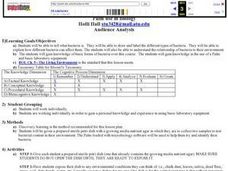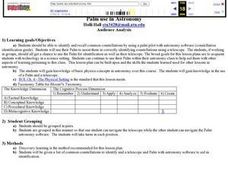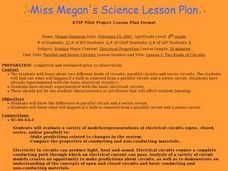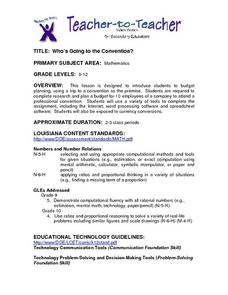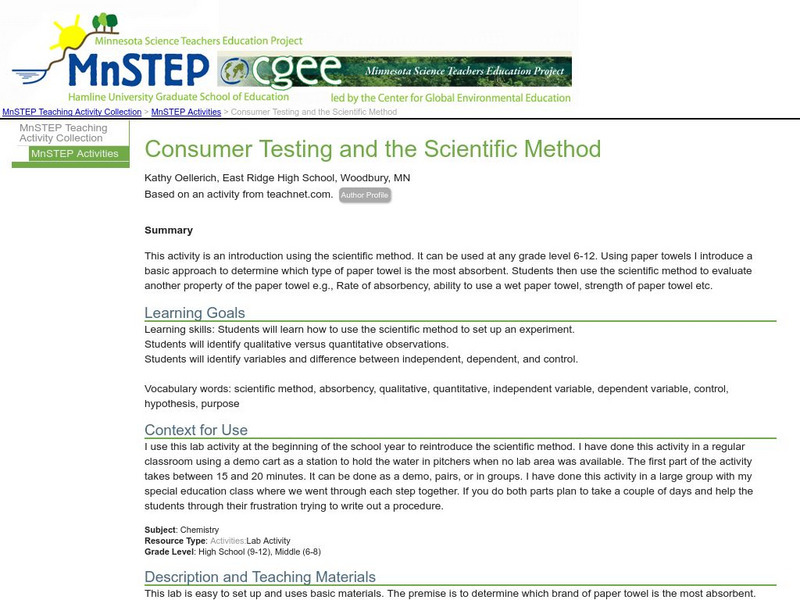Curated OER
Ecology and the Conservation of Natural Resources Lesson 2
Students compare and contrast abiotic and biotic factors. They discuss how these factors effect ecosystems. They answer questions to complete the activity.
Curated OER
Plants and Animals Depend Upon One Another
First graders study plants and animals and how they depend on one another. They also study that plants give energy to animals and provide oxygen needed for life. Finally, 1st graders give examples of the roles plants and animals play...
Curated OER
Pedestrian Safety for Students
Students create a spreadsheet. In this spreadsheet instructional activity, students take the responses they received from a pedestrian safety survey to create their spreadsheet. Then they turn this information into a graph.
Curated OER
Palm Use in Biology
Students view bacteria through a microscope. They draw and label the bacteria using microbiology software loaded onto their Palms.
Curated OER
Creating and Maintaining a Budget
Students explore the videogame, Sim City to create functioning cities. They develop and maintain a budget for their cities, and present their city using a Powerpoint presentation.
Curated OER
A Living Watershed
Pupils, through this series of lessons, use local resources, speakers, print and video materials, as well as standard text materials to study the ecosystem of the local watershed.
Curated OER
Palm use in Astronomy
Students identify and recall common constellations by using a palm pilot with astronomy software. Students will use their Palm to assist them in correctly identifying constellations using a telescope.
Curated OER
Meterology -- Atmosphere
Fourth graders discover how weather predictions are made. They list the responsibilities of a meteorologist. They identify weather instruments and state their functions.
Curated OER
Observation
Students practice observation skills by discussing physical attributes of family artifacts. They determine what characteristics of an object are considered important details.
Curated OER
Two Kinds of Circuits
Fourth graders examine parallel and series ciruits. They experiment what happens if a bulb is removed from both a parallel and series circuit. They understand the differences between parallel and series ciruits,
Curated OER
Mixed Expressions and Complex Fractions
Students are introduced to mixed expressions and complex fractions. They work through several problems with the instructor and then complete a worksheet.
Curated OER
Comparing Weather Conditions
Students conduct research on temperature, wind speed and weather conditions from a variety of areas. They organize their findings on worksheets and spreadsheets and discuss various examples of databases.
Curated OER
Before We Travel, We Research
Students conduct research on a historical site in preparation for a field trip. In small groups, they conduct research, and present the information to the class in the form of a PowerPoint presentation or poster.
Curated OER
Blood Business
Students identify the different kinds of blood. In this biology instructional activity, students investigate the antigens, agglutinins and Rh factor using their own blood. They use Punnett squares to predict blood type of offspring.
Curated OER
Pottery Analysis
Students study how archaeologists analyze artifacts to answer questions about past cultures. They explain why pottery is important to archaeologists and how they use classification to answer their research questions.
Curated OER
Who's Going to the Convention?
Students practice planning budgets as they create a budget for ten employees of a company to attend a professional convention. They use the Internet, and spreadsheet software to complete their assignment.
Science Education Resource Center at Carleton College
Serc: Consumer Testing and the Scientific Method
Using paper towels, introduce a basic approach to determine which type of paper towel is the most absorbent using the scientific method. Students learn to evaluate properties of paper towels: rate of absorbency, ability to use a wet...
Alabama Learning Exchange
Alex: Bubble Bubble
This lesson plan will help young students understand the shape and movement of bubbles. Students will predict, practice, and record results as they blow bubbles with different-shaped objects.
Science and Mathematics Initiative for Learning Enhancement (SMILE)
Smile: Magnet Muscles (Lesson Plan)
A teacher lesson plan which includes a station lab; students navigate through four stations with separate activities on magnetic principles. Easily adaptable as a student project.



